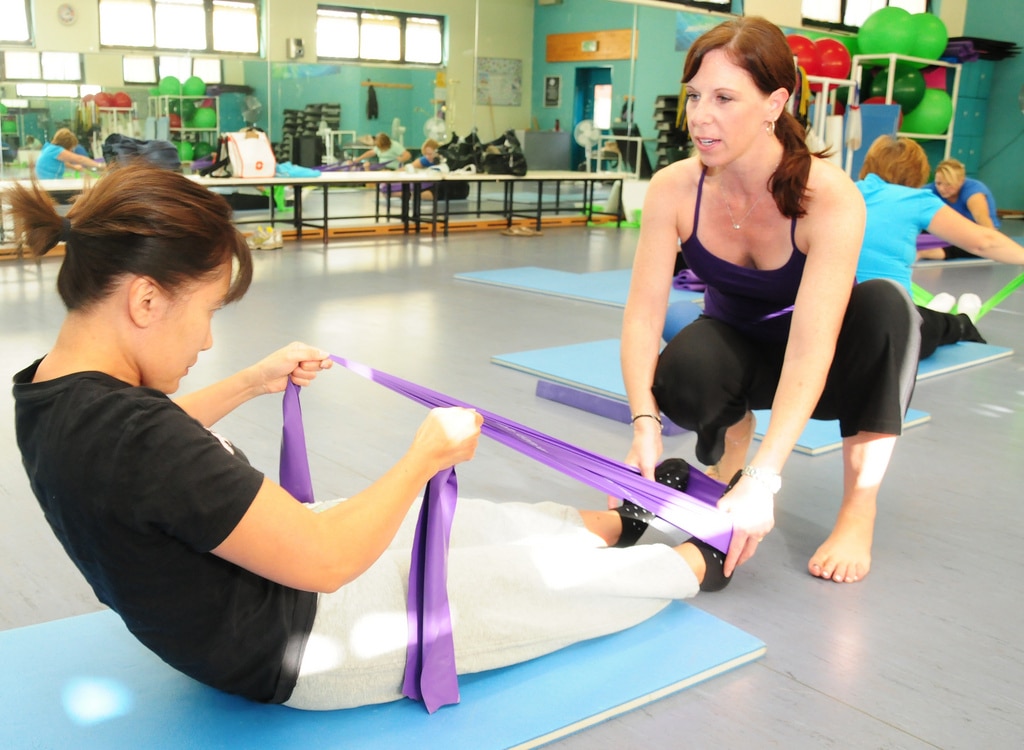Prerequisite knowledge required: Basic knowledge of Hip flexor anatomy.
Hip flexor injuries are the third most common type of injury for runners [1]. Athletes in multiple sports, including soccer and hockey have a 12% yearly incident of a hip or groin injury [2]. Even if you are not an athlete, there are still several ways that you could hurt them in your daily life, that will be addressed in this guide. You will learn how to differentiate types of pain, how pain corresponds to different injuries, and how to diagnose and treat your injury.
Guide Contents
Common Causes of a Hip Flexor Injury
While injuries occur predominantly during athletic events, all of the following risk factors can increase your chance of incidence in ordinary circumstances. There are 3 main factors that contribute, it is possible for more than one to contribute to an injury:
1. Muscular Imbalance
When a set of opposing muscles (two muscles that perform opposite functions) have different levels of strength, you increase your chance of getting hurt [3].
The Hip Flexor as a muscle group contains several sets of opposing muscles, all of which are needed for common athletic movements, which explains some of the prevalence of soft tissue injuries in sport.
2. Weak or Tight Muscles
This is again a concern for athletes. If you have a weak muscle and exert a great amount of stress on it, it is likely to cause damage to the muscle or surrounding tissues (ligaments, tendons etc.). Muscles in the hip region are expected to perform under extreme forces of over 20 times your bodyweight [4]. Similarly, chronically tight muscles have a reduced stress threshold, just like a stretched elastic band.
3. High Intensity Training
In a similar mechanism to damaging weak muscles, it is possible to over-exert your muscles while performing high intensity activities. Having poor technique, equipment (shoes) or performing it on a slippery or uneven surface increases the risk of injury.
Types of Hip Flexor Injuries
Many sources focus on the most prevalent type of injury, strains, but in reality there are several types:
-
Skeletal: Fractures, bone bruising
-
Articular: Arthritis, tendonitis
-
Soft Tissue: Bursitis, snapping hip syndrome, pointers (bruises), strains
-
Neural: Trapped/inflamed nerves
-
Referral: Spine injuries that cause hip pain
-
Developmental: Rare diseases and disorder affecting bone and tissue growth
-
Other: Various diseases, tumors, infections etc.
Identifying the Type of Your Injury
Many injuries can be identified by addressing a few points in a subjective test, which is what a medical professional will likely start with. They can then can be confirmed with objective tests that determine your current strength, flexibility and pain abilities.
Subjective Tests:
There are a variety of questions you should attempt to answer to understand your injury better:
-
Location of pain: Does it hurt in one area or multiple?
-
Patterns of pain: Does the time of the day have any effect on the severity of the pain? Is it a sharp pain or a dull radiating pain?
-
Functional difficulties: Does it hurt when you perform any specific movements to your knowledge. If so, what are the movements?
-
Aggravating factors: What makes it start to hurt more. Common factors are heat, movement (walking, running, climbing stairs etc.), and sitting or lying in certain positions
Remember your answers to those questions going forward as they will help you narrow down the cause.
Practical Tests
Now that you understand the background of your injury a little better there are a few practical tests that you can do to gain more information.
Being with a series of range of motion tests. Since the Hip Flexor is involved in many different movements you should try the following:
**Go slow and always in a controlled movement and try both legs individually and compare.
1. Knee to Chest: Simply lift up one knee and try to reach it as far up as possible to your chest. If you experience pain at any point stop and take a note.
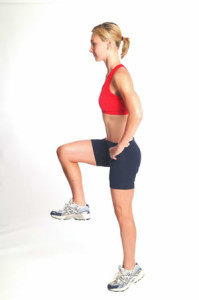
2. External and Internal Rotation: Lift up your knee to a 90 degree angle in front of you. Without turning your whole body, rotate your leg to your side, and then back across your body. Note any pain.

3. Leg Swing Front and Back: Put all of your weight on one leg and swing the other leg in front of you and then behind you.

4. Leg Swing Side to Side: Put all of your weight on one leg and swing the other leg side to side in front of your body.
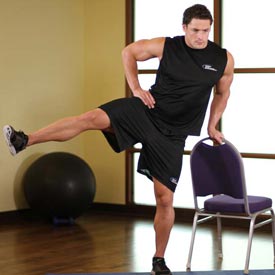
An injury will typically reveal itself during those 4 tests through some type of pain. Regardless of it did or not, you should now move onto palpation. Palpation simply means to feel, press various points around the area to locate where and how deep the pain is.
Figuring out what type of pain and why you are experiencing it is necessary to understand your injury and treat it.
Determining the Type of Hip Flexor Pain
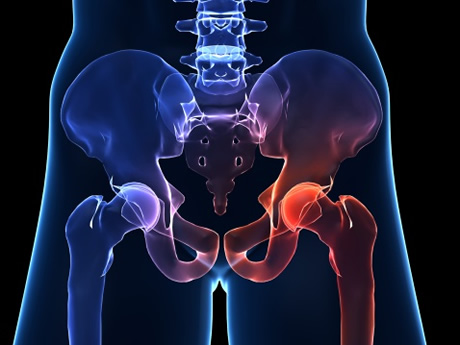
Not all injuries are created equally, for example an ankle sprain feels different than a bruise. Because the Hip Flexor is a complicated muscle group with many different muscles and other structures like nerves, bursae and tendons in the region, there are many different types of pain you can suffer.
Sharp/Stabbing Pain
If you’re able to move about fine for the most part, but seem to almost randomly get sharp, stabbing pains in your hip region, the issue is most likely nerve related. Nerves run throughout your body, and considering how close the Hip Flexors are located to your spine, there are many opportunities for them to become damaged or pinched.
Burning Sensation
Muscles and even tendons can become inflamed when put under excess stress or damaged by some sort of trauma. The pain typically associated with inflammation is a dull burning pain that radiates outwards from the point of damage. Injuries like tendonitis and snapping hip syndrome are examples of inflammation injuries.
Other Pains
There are many types of pain that don’t fit into the above two categories. There are some that seem like a constant (chronic) pain, and some that only occur under certain circumstances, which are addressed below in the next section.
Classifying the Type and Cause of Your Hip Flexor Pain
[adinserter block=”1″]
Very often when it comes to soft tissue injuries, you’ll only really notice the pain during certain activities.
Pain in Hip Flexor During Stretch

It’s possible to feel pain when you stretch your Hip Flexors, even during a slight stretch like when you’re walking. It’s important to differentiate between pain and discomfort, as people with tight Hip muscles will feel discomfort and tension when stretching, but that doesn’t mean anything is necessarily injured. Now if you do actually feel pain while stretching, it’s likely indicative of a muscle injury and it’s important you don’t stretch it anymore, as it will exacerbate the damage.
Hip Flexor Pain During Activity

There are times where you may be able to stretch and do all normal movements without any pain, but then you start running or some kind of activity and notice pain in your Hip Flexor. This is very common with less severe Hip Flexor injuries, especially with low grade strains. This is an indication that some of your muscles are weak and need to be strengthened.
Clicking
If you have pain simultaneously with a loud clicking sound, there is one injury in particular that is common with athletes that can cause this called Snapping Hip Syndrome. It’s an overuse injury that causes an inflamed tendon to get stuck on bone and make a ‘snap’ or ‘click’ sound.
Note that you can have more than one type of pain. Many injuries will not just damage one structure in the hip region, but many.
Once you have a better handle on what injury you have, you can move onto identifying how serious it is.
Determining the Severity
If you have experience with similar injuries in the past you may have a sense for the severity of the injury by the pain you are experiencing. Otherwise, in order to objectively identify the severity you should perform both muscle strength and flexibility tests.
Certain injuries like strains are associated with a weakened muscle (because of tearing) and inflexibility (because of inflammation).
Strength: Try to find a machine at a gym or physiotherapy office that allows you to perform weighted leg raises. Perform the exercise slowly with each leg and record any significant strength differences. Here are some common Hip Flexor strengthening exercises you could use as tests.
Flexibility: Lie flat on your back and bring your knees towards your chest with your feet on the ground. Pain indicates a lack of flexibility as well as an angle from your chest to your thighs of more than 120 degrees.
To determine if there is a neural issue stay lying on your back with your legs extended on the floor. One leg at a time, raise your single leg up to a 90 degree angle. A stretching sensation is normal but pain is typically caused by a trapped or impeded nerve.
Note that you should try a variety of stretches in order to see if any minor muscles are damaged.
Diagnosing Your Hip Flexor Injury
Now that you have compiled information about your injury it is time to attempt to identify your specific issue, learn more about it, and get the specific treatment you need.
Here is a brief description of common injuries as well as a link to an article where you can learn more about it and treatment options.
Hip Flexor Strains
Anyone who plays sports is likely to suffer a hip flexor strain (or pull) at one point or another. It’s a common injury that can hamper you in your daily life due to a severe amount of pain, as well as preventing you from engaging in athletics of any type.
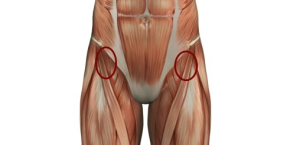
A muscle pull occurs when you place more stress on a muscle than it can handle. This commonly occurs when it is fully extended and at its weakest. For example, pulled Hip Flexors are very common in sprinters, who place a great deal of force on them as their leg extends behind their body. In this full stretch your main muscles, comprising the Iliopsoas, are at high risk.
The most common symptoms of a strain is a tearing or popping sound when it occurs and immediate pain. You’ll often notice that the pain subsides when you place light pressure (with a brace or your hand) on the location of the tear. This is because it helps the rest of the muscle tissue stay together.
Classifying Your Pull
Each muscle contains thousands of fibers. A strain is literally a tearing of those muscle fibers. In general there are three degrees of pulled muscles that are used to classify the severity of the injury. All of the degrees exist on a spectrum of muscle damage, so remember that two injuries that are both a first degree injury may not be the exact same severity.
First Degree Hip Flexor Strain
If you’re lucky you’ll only have a first degree pull. This is a minor tear to the muscle, typically only a few or few dozen muscle fibers. It can heal fairly quickly, usually within a week or two. You may not have noticed the instant when your tore your muscles, but then notice pain and soreness afterwards.
Second Degree Hip Flexor Strain
A partial tear of the muscle is considered a second degree issue, where a significant amount of muscle fibers have been torn. It will cause considerable pain and probably make it difficult to move your leg (or any movement that requires your Hip Flexor). Bruising and swelling is not uncommon, but usually subsides rather quickly. With proper treatment, a second degree pulled muscle takes anywhere from four to eight weeks to heal.
Third Degree Hip Flexor Strain
Following the pattern, a third degree strain is the worst, a complete rupture of the muscle. This is obviously very painful, and will likely cause swelling and make it difficult to move your leg at all. If you suspect there’s a chance of a third degree tear, get to a doctor as soon as possible.
Assessing the Damage
Pain is not always a perfect indication of the severity of the damage. When you see a sports physician, he/she will assess the injury based on strength and flexibility. By testing both the healthy leg and the damaged leg, you can see the difference in them.
If there is no loss or very little loss in flexibility or strength, it’s considered a grade one sprain. A second degree pull is indicated by a significant loss of strength or flexibility and so on.
An Advanced Way to Classify Pulled Muscles
If your body is part of your work or is something you need at 100 percent, there is a further option to gauge exactly how bad the damage is. What the above system does not take into account, is the location of the strain, i.e. distance from muscle attachment, and depth of the tear.
One way to see the real damage is with an MRI (Magnetic resonance imaging) [1]. Below is a typical MRI image for reference. Your doctor will be able to tell you the exact level of your strain, which may affect your recovery plans.

Hip Flexor Strain Treatment
Seeing a physician is always a good idea, he/she will be the only one with enough experience to accurately identify the severity of your strain. If you’re looking for best practices for pulled muscle treatment, refer to our article on Hip Flexor injury treatment.
Tendonitis
Tendonitis is an inflammation injury, often the result of overuse of one, or multiple muscles. It is typically a dull, burning sensation in the area of the inflamed tendon. Pain is caused when other internal tissues make contact with the tendon. Learn more about hip flexor tendonitis here.
Snapping Hip Syndrome
Like tendonitis, this is typically an overuse injury. It is fairly easy to identify because of the snapping sound that your joint makes when making a particular movement (very common in dancing). Depending on the severity, there is not always pain associated with it. Patients with tendonitis must rest until the inflammation subsides, and then strengthen the surrounding muscles to ensure that it does not return.
Pointers
A pointer is a bruise that is usually caused as a result of a blunt trauma, which can occur in sports or anytime in daily activities. Usually not serious, but can cause pain when touched. Pain often gets better after movement or stimulation (light massage) allows more blood to flow to the area. Most will heal within a few weeks, and activity can typically be continued with no side effects. Severe pointers should be examined by physicians.
Hip Bursitis
Also an inflammation injury, bursitis is caused by inflammation of one or more bursae. A bursa is a gel-containing sac that cushions vital internal structures during movement. When they get inflamed, they will cause pain when touched.
If you have a good idea of what might be causing your injury, you can now look into Hip Flexor injury treatment.
